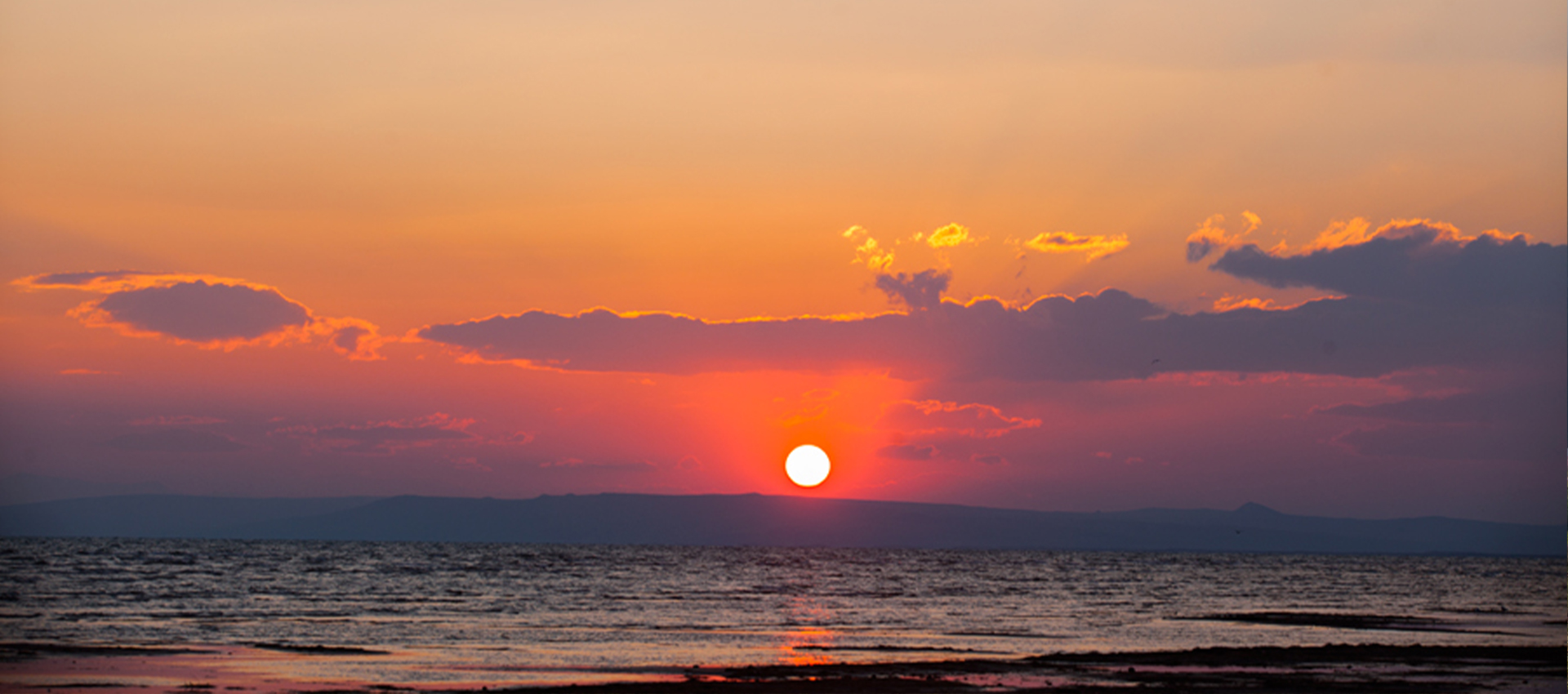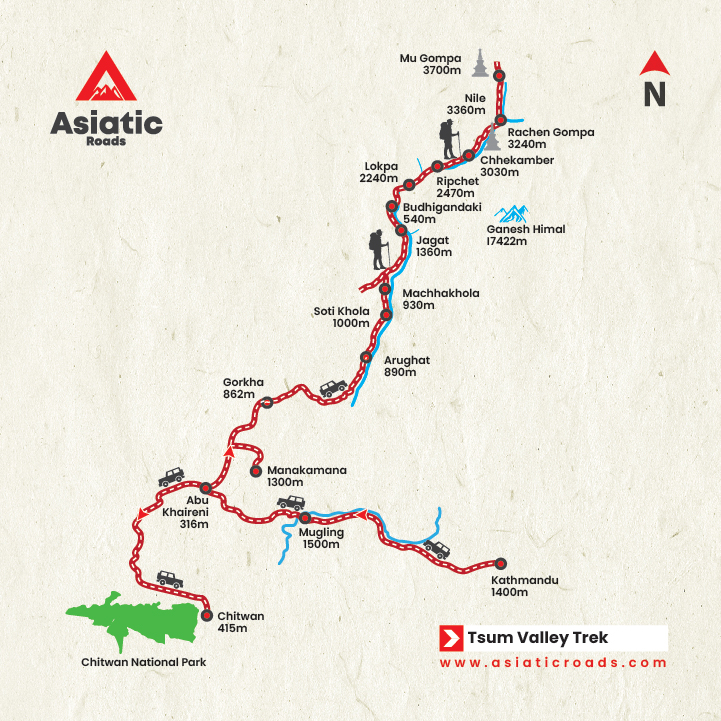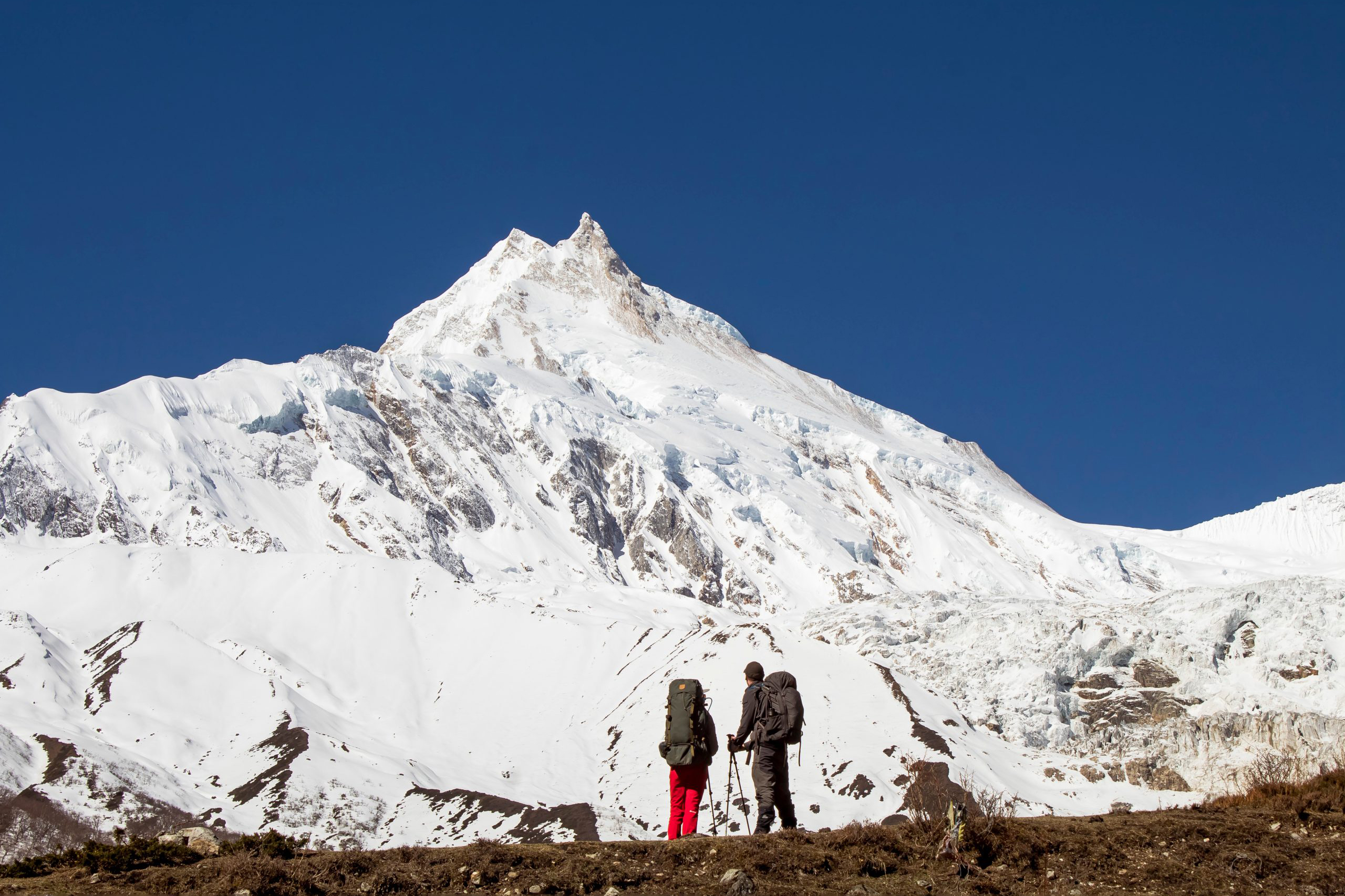
Trekking to Tsum Valley
- Home /
- Nepal /
- Trekking & Hiking /
- Manaslu Conservation area /
- Trekking to Tsum Valley
Tsum Valley was a restricted area until it was opened for trekking in 2008 and there is a little information available on the area.
The Tsum Valley is a sacred Himalayan pilgrimage valley situated in northern Gorkha, Nepal. Literally “Tsum” means vivid. Against the majestic backdrop of the Ganesh Himal and Sringi Himal, and Boudha ranges, this serene Himalayan valley is rich in ancient art, culture and religion. The local people are mostly of Tibetan origin and speak unique dialect. Trails are strewn with artistic chortens and lined with mani walls made of thousands of stone slabs carved with drawings of deities and inscribed with prayers. The famous Kyimu Lung, a pilgrimage circuit in the central Trans-Himalaya, is well known for its center of learning and meditation.
This circuit traverses the Tsum Valley the Manaslu area in Nepal, and southern parts of Tibet, it has long history of Buddhism. The Buddhist saint Milarewa is believed to be meditated in the caves of these mountains. Traditionally, the valley was a culturally distinct geographical called “Tsum Tso Chuksum”, which means thirteen provinces ruled as a single territory. The ancient remains of the Tsum Kingdom are still visible today.
Route Map

Itinerary In Detail
-
Day 01: Arrive in Kathmandu (1,400 m / 4,592 ft.)
Upon arrival in Tribhuvan International airport meet Himalayan Holidays representative and transfer to Hotel.
Eve: Welcome dinner with Nepali culture dance.
Overnight at hotel in Kathmandu -
Day 02: Trek preparation and sightseeing day in Kathmandu
Am: After breakfast, proceed for a sightseeing tour of Kathmandu City. It includes visit to the Bouddhanath Stupa, the biggest stupa in Nepal. This is also called by many as Khasti Chitya, is one of the oldest stupas in the country. The stupa, a well-known Buddhist pilgrimage site, is included in World Heritage Cultural site list by UNESCO. With diameter of about 100m and 40m height, Buddhanath holds its place among the largest Stupa in the world!
Later proceed to Pashupatinath Temple, with its astonishing architectural beauty, stands as a symbol of faith, religion, culture and tradition. Regarded as the most sacred temple of Hindu Lord Shiva in the world, Pashupatinath Temple’s existence dates back to 400 A.D. The richly-ornamented pagoda houses the sacred linga or phallic symbol of Lord Shiva. Thousands of pilgrims from all over the world come to pay homage to this temple that is also known as ‘The Temple of Living Beings’, which is listed UNESCO world heritage Site. Later transfer back to hotel for some rest and refreshment.
After visiting Pashupatinath Temple proceed for sightseeing tour of Kathmandu Durbar Square. Listed as one of the eight Cultural World Heritage site by UNESCO, Kathmandu Durbar Square is a cluster of ancient temples, palaces, courtyards and streets that date back to the 12th and 18th centuries. The square is known to be the social, religious and urban focal point of the Capital City. The Palace Complex was the royal Nepalese residence until the 19th century and was the site of important ceremonies, such as the coronation of the Nepalese monarch. We can also visit Temple of Living Goddess “Kumari”, and the Kasthamandap Temple, which is believed to be constructed from the wood of a single tree from which Kathmandu derives its name
Pm: Free for trek preparation – briefing and orientation etc.
Eve: Traditional Welcome dinner followed by Nepali Cultural program.
Overnight at hotel.
-
Day 03: Drive to Machhakhola via Dhading Besi (900 m /2,952 ft.) – 155 km / 6~7 hours
After breakfast start drive via Kathmandu – Pokhara Highway to Malekhu. Leaving Highway continue to drive to Dhading Besi and to Arughat for lunch. After lunch continue drive through unpaved road to Machhakhola passing through Soti and Likhu Village.
Overnight at Teahouse lodge.
-
Day 04: Trek to Jagat (1,360m / 4,460 ft.) - 5~6 hours.
After breakfast, cross the Machha Khola- Fish Stream- and head upstream to the tiny village of Khola Bensi and the hot springs at Tatopani (which I want to investigate). The valley sides steepen until they are impassable and the route then switches to the left bank by way of a suspension bridge. The trail is quite exposed and challenging in places. After a short section of forest path we reach the single tea house at Doban. Above Doban, the Buri Gandaki descends an impressive series of rapids. Beyond this steep section, the river is much more placid, meandering across a broad gravel bed. At Lauri, we re cross the river on a suspension bridge and then climb on a high path to the fields of Jagat, where we camp.
Overnight at Teahouse lodge.
-
Day 05: Trek to Lok Pa (2,240 m / 7,347 ft.) – 5~6 hours
The trail from Jagat descends to the pleasant village of Salleri. It also has a slate paved main street and friendly villagers. About 2 and half hours from Jagat you reach Sirdibas (1,430m), a compact village with nice stone houses and slate roofs. We then pass the small village of Ghote Khola before crossing the Budhi Gandaki on one of the longest suspension bridges of this trek, followed by a steep climb to Philim.
Above Philim the sheer scale and the feeling of being truly amongst the mighty Himalaya is evident at every turn. We cross the Budhi Gandaki yet again, the trail hugging the cliff-side, up and over ridge backs, as we gaze across the valley at cascading waterfalls. Within two hours the trail splits, with one route heading northwest up the Manaslu Circuit towards the Larkye La pass, and our route heading northeast along the Syar River toward the Tsum Valley. After a steep climb through pine forest the trail levels out and we reach the Lok pa where there is a small teahouse on the main trail a few hundred meters below the village.
Overnight at teahouse lodge.
-
Day 06: Lok Pa to Chumling (2,386m / 7,826 ft.) – 4~5 hours
Although we will only gain a few hundred meters altitude overall today it will be up and down all the way along the steep valley walls above the Syar River. We start by descending down to the river, then climb steeply and staying high above the river for a long stretch before returning to cross an old bridge to the north side. From here it’s a steady climb up to Chumling, surrounded by open meadows and planted fields that contrast starkly with the deep forest on the opposite side of the valley. We will overnight at the spacious teahouse here with splendid views. Across the valley we can spot the trail leading through Ripchet, an alternate route from Lok Pa.
Overnight at teahouse lodge.
-
Day 07: Chumling to Chukkum Paro (3,031m / 9,941ft.) – 4~5 hours.
After an easy start today along a gentle downward trail we’ll cross the river again. From here it’s mostly straight up for a few hours, first through a mix of pine and deciduous forest, then opening up to arid terrain of the high plateau with broad meadows and squat shrubbery. As we crest the plateau about 15 minutes before reaching Chukkum Paro the Tsum Valley opens up and we see the full breadth and depth of this geological wonder.
When we reach Chukkum village you will be fully enveloped in the Tibetan Buddhist culture of the indigenous “Tsumbos”. Small gompas dot the outskirts of the village where solidly built slate-roofed houses are packed closely together, like herds of yaks shielding themselves against harsh winter weather. During the trekking season though you can expect warm, sunny days with chilly evenings.
Overnight at teahouse lodge.
-
Day 08: Trek to Nile/Chule (3,300m / 10,824 ft.)
It’s an easy hike along well-constructed trail sand through primitive yet quite neat little villages toward the larger villages of Chule and Nile, which face each other on opposite sides of the Syar River at the base of the comma-shaped, steep valley leading up to Mu Gompa. A huge headwall with an icy waterfall dominates the background of Chule. About 100 meters above the village looms a 700 year old Buddhist monastery that we can visit before or after crossing the river to Nile where we will stay in a comfortable and hospitable local home. This will be a relatively easy day with lots of time in the afternoon for relaxation and exploration.
Overnight at teahouse lodge.
-
Day 09: Hike Mu Gompa (3,700 m / 12,136 ft.)
We will start early alongside the Syar river leading up the valley to Mu Gompa. The trail steepens sharply as we approach the Gompa after an hour or two of hiking. We will still be engulfed in the shadows of the deep valley but will see the monastery above us lit up brightly as the sun’s rays spill unfettered down another high valley to the east, as through a window. There will be plenty of time to explore the monastery complex and its gompa. The views looking back down the valley toward Ganesh Himal are spectacular, with the stark valley terrain serving as a perfect backdrop for the sparkling whiteness of the snow-capped peaks surrounding us. Depending on our trek pace and group interests it may also be possible to explore other gompas and vistas in the mountains surrounding Mu Gompa. There are overnight accommodations at Mu Gompa where we will have the option of staying, or return to Nile (one and a half hours away) for lunch. Rest of the day is for leisure.
Overnight at teahouse lodge. -
Day 10: Back track to Chumling
As we start to make our way down the valley you will have a different mountain views, dominated by the broad face of Ganesh Himal. You should also have a fresh and well-informed perspective on the region and its culture as you revisit the villages and people along the route home. Along the way we will stop at Ranchen Gompa, a sprawling nunnery that hosts hundreds of Buddhist aspirants from around the world each year.
As we approach Chumling the terrain will once again be transformed, this time from arid high plains to verdant forests.
Overnight at teahouse lodge. -
Day 11: Trek to Chisopani via Lok pa.
We descend rapidly from the Tsum Valley today, although not without some challenging ascents and descents on the valley walls, before reaching Lok Pa where we will have lunch. From Lok Pa, we soon meet the Budhi Gandaki River again as we make our way back to Chisopani.
Overnight at teahouse lodge. -
Day 12: Backtrack to Machhakhola
After breakfast start backtrack to Machhakhola.
Overnight at teahouse lodge. -
Day 13: Drive to Kathmandu – 6~7 hrs
After breakfast get into to waiting vehicle and start drive to Kathmandu.
Overnight at hotel -
Day 14: Final departure
Free until final departure transfer to Kathmandu’s International Airport.
14 Days From

Any Question?
Feel free to call our travel experts.
+977 9851189018, +977 9801089018
info@asiaticroads.com
14 Days From

Any Question?
Feel free to call our travel experts.
+977 9851189018, +977 9801089018
info@asiaticroads.com
14 Days From

Any Question?
Feel free to call our travel experts.
+977 9851189018, +977 9801089018
info@asiaticroads.com
Reviews
In my 2 week stay, John was very professional and took me around to experience all that Kathmandu and surrounding areas has to offer. Sites were seen and many locals were met through John’s network.

Steven Stone
TravellerIn my 2 week stay, John was very professional and took me around to experience all that Kathmandu and surrounding areas has to offer. Sites were seen and many locals were met through John’s network.

Steven Stone
Traveller14 Days From





